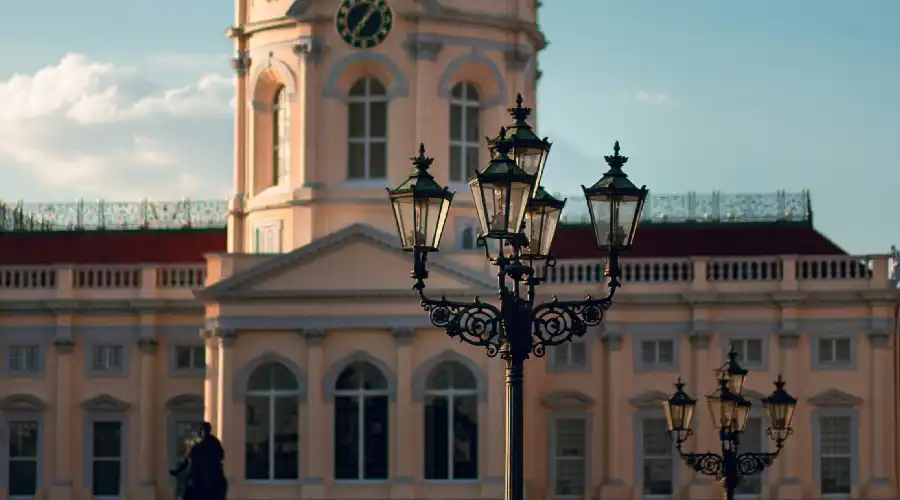Charlottenburg Castle

About Charlottenburg Castle
Called the Schloss Charlottenburg in its original language, this baroque palace is the heart and soul of the city’s Charlottenburg district, holding access to a wealth of history that marks the place apart from the other palaces in the area. Traveling to Berlin wouldn’t be complete without visiting Charlottenburg Castle, for its grandeur stands as a testament to Prussian royalty and rises above all else as a cultural landmark not to be ignored – just as Prussian Monarchs refused to be ignored.
History Of The Charlottenburg Palace
In the late 17th century, Sophie Charlotte, the wife of King Friedrich, commissioned the construction of Charlottenburg Palace, a masterpiece designed by Johann Arnold Nering. Later, under King Friedrich’s reign, the palace was expanded by architect Johann Friedrich von Eosander and housed the famous Amber Room, considered the “eighth wonder of the world.” Despite facing changes over the centuries, including destruction during World War II, the palace was reconstructed between 1957 and 1970, preserving its historical significance. Today, Charlottenburg Palace is a testament to its rich history and architectural grandeur.
The castle offers a fee for two public areas: the Old Palace and the New Wing. The Old Palace features lavishly decorated Baroque-style rooms, including the renowned Porcelain Cabinet with an extensive collection of porcelain. Intricate stuccowork and gilded accents adorn the interior. In contrast, the New Wing showcases a Rococo style, known for its luxury and elegance, housing state and winter apartments of royals. Additionally, the castle grounds contain a mausoleum where Prussian royalty, including Queen Louise, have been laid to rest for centuries.

Tips for Your Visit to the Charlottenburg Castle
- Plan Your Visit: Plan it to make the best of your visit. Note the timings to make sure you don’t miss out – for example, in Winters, the castle is only open from Tuesdays to Sundays, 10 A.M. to 4:30 P.M.
- Guided Tours: When you take tours offered by experienced guides who have insights into the knowledge and history of the place, you’ll be able to understand a perspective otherwise unexplored. You can also cut down on locations that aren’t as significant.
- Charlottenburg Castle Map: Look at a map to understand your destination more easily, especially if you don’t have a guide. You can narrow down your higher priorities and work accordingly.
- Visit the Gardens: If you want a break from the man-made luxury, stroll through the expansive palace gardens, which, though designed in the English landscape style, are still some of the best natural sights you can see. Admire the lush greenery, tranquil water features, and ornate sculptures.
- Check for Special Events: Keep an eye out for events, exhibitions, and concerts because the castle is a highly in-demand location, and you can always enjoy a new experience. From classical music performances to themed exhibitions, there’s always something new to discover!
Charlottenburg Palace Tickets
Buying tickets for Charlottenburg Castle can be done online – the most recommended option – to skip the line and plan your visit. Moreover, to clarify which ticket you want to buy, you must narrow down where you want to visit. The basic admission tickets allow you to explore the Old and New Wings. Still, for an extra charge on your Charlottenburg Castle tickets price, which supplements the basic ticket, you can also access the New Pavilion, Belvedere, and the Mausoleum.
If you’re there with a family, a family ticket is also available and is a better choice than buying tickets individually. If you’re a frequent visitor (and just can get enough of the castle), you can also get a yearly ticket. But, again, this is only relevant for frequent visitors, and the other options are better choices for those who only come by once or twice in their lives, let alone once a year. Or, if you choose the Charlottenburg+ ticket, you can gain access to all locations on the ground and be able to save! The single Charlottenburg Castle tickets price is usually between €8.00 and €12.00. The Charlottenburg+ price is from €14.00 to €19.00, and the family ticket is €25.
How to Arrive to the Charlottenburg Castle
Charlottenburg Castle is easily accessible by public transportation and is placed near several bus stops and stations served by various routes. As a visitor, you can also reach the castle by tram or taxi, with designated drop-off points near the main entrance, but public transport often seems the better option.
By Train: To take the train to the Charlottenburg Station, use lines S41, S42, or S46 – the S Westend is only 12 minutes away by walk.
By U-Bahn: The subway only requires you to take the U2 or the U7, and the stations nearest are the U Richard-Wagner-Platz and the U Sophie-Charlotte-Platz. By Bus: The Castle can be reached via bus on the 109, M27, and M45 lines, and you can get off at the Schloss Charlottenburg bus stop or the Luisenplatz/Schloss Charlottenburg stop.









